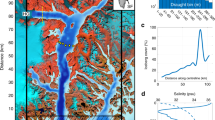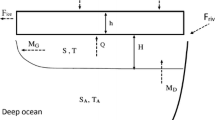Abstract
The physical and biological environment of the Barents Sea is characterised by large variability on a wide range of scales. Results from a numerical ocean model, SINMOD, are presented showing that the physical variability is partly forced by changes in annual net ice import. The mean contribution from ice import in the simulation period (1979–2007) is about 40% of the total amount of ice melted each year. The annual ice import into the Barents Sea varies between 143 and 1,236 km3, and this causes a substantial variability in the amount of annual ice melt in the Barents Sea. This in turn impacts the freshwater content. The simulated freshwater contribution from ice is 0.02 Sv on average and 0.04 Sv at maximum. When mixed into a mean net Atlantic Water (AW) inflow of 1.1 Sv with a salinity of 35.1, this freshwater addition decreases the salinity of the modified AW to 34.4 and 33.9 for the mean and maximum freshwater fluxes, respectively. Ice import may thus be important for the Barents Sea production of Arctic Ocean halocline water which has salinity of about 34.5. The changes in the ice melt the following summer due to ice import also affect the formation of dense water in the Barents Sea by changing stratification, altering the vertical mixing rates and affecting heat loss from the warm AW. The model results thus indicate that ice import from the Arctic has a great impact on water mass modification in the Barents Sea which in turn impacts the ventilation of the Arctic Ocean.












Similar content being viewed by others
References
Aagaard K, Woodgate RA (2001) Some thoughts on the freezing and melting of sea ice and their effects on the ocean. Ocean Model 3(1–2):127–135
Abrahamsen EP, Østerhus S, Gammelsrød T (2006) Ice draft and current measurements from the north-western Barents Sea, 1993–96. Polar Res 25(1):25–37
Ådlandsvik B, Loeng H (1991) A study of the climatic system in the Barents Sea. Polar Res 10:45–49
Bengtsson L, Semenov VA, Johannessen OM (2004) The early twentieth-century warming in the Arctic—a possible mechanism. J Climate 17:4045–4057
Budgell WP (2005) Numerical simulation of ice-ocean variability in the Barents Sea region. Ocean Dynamics 55:370–387. doi:10.1007/s10236-005-0008-3
Dankers R, Middelkoop H (2008) River discharge and freshwater runoff to the Barents Sea under present and future climate conditions. Clim Change 87(1–2):131–153. doi:10.1007/s10584-007-9349-x
Ellingsen IH, Dalpadado P, Slagstad D, Loeng H (2008) Impact of climatic change on the biological production in the Barents Sea. Clim Change 87(1–2):155–175
Furevik T (2001) Annual and interannual variability of Atlantic Water temperatures in the Norwegian and Barents Seas: 1980–1996. Deep-Sea Res Part 1, Oceanogr Res Pap 48(2):383–404
Gammelsrød T, Leikvin Ø, Lien V et al (2008) Mass and heat transports in the NE Barents Sea: observations and models. J Mar Syst. doi:10.1016/j.jmarsys.2008.07.010
Harms I (1997) Water mass transformation in the Barents Sea—application of the Hamburg Shelf Ocean Model (HamSOM). ICES J Mar Sci 54:351–365
Harms IH, Karcher MJ (2005) Kara Sea freshwater dispersion and export in the late 1990s. J Geophys Res 110:1–9
Hibler WD III (1979) A dynamic thermodynamic sea ice model. J Phys Oceanogr 9:815–846
Hunke EC, Dukowicz JK (1997) An elastic-viscous-plastic model for sea ice dynamics. J Phys Oceanogr 27(9):1849–1867
Ingvaldsen R, Loeng H (2009) Physical Oceanography In: Sakshaug E, Kovacs K, Johnsen G (eds) Ecosystem Barents Sea. Tapir Academic Press, Trondheim, Norway
Ingvaldsen R, Loeng H, Asplin L (2002) Variability in the Atlantic inflow to the Barents Sea based on a one-year time series from moored current meters. Cont Shelf Res 22(3):505–519
Ingvaldsen RB, Asplin L, Loeng H (2004) The seasonal cycle in the Atlantic transport to the Barents Sea during the years 1997–2001. Cont Shelf Res 24(9):1015–1032
Kwok R, Maslowski W, Laxon SW (2005) On large outflows of arctic sea ice into the Barents Sea. Geophys Res Lett 32:L22503. doi:10.1029/2005gl024485
Loeng H (1991) Features of the physical oceanographic conditions of the Barents Sea. Polar Res 10:5–18
Martinsen E, Engedahl H (1987) Implementation and testing of a lateral boundary scheme as an open boundary condition in a barotropic model. Coast Eng 11:603–727
Maslowski W, Marble D, Walczowski W et al (2004) On climatological mass, heat, and salt transports through the Barents Sea and Fram Strait from a pan-Arctic coupled ice-ocean model simulation. J Geophys Res 109:C03032. doi:10.1029/2001jc001039
McClimans TA, Nilsen JH (1993) Laboratory simulation of the ocean currents in the Barents Sea. Dyn Atmos Ocean 19(1–4):3–25
McClimans TA, Johnson DR, Krosshavn M et al (2000) Transport processes in the Kara Sea. J Geophys Res 105:14121–14139
Midttun L (1985) Formation of dense bottom water in the Barents Sea. Deep-Sea Res 32:1233–1241
Nansen F (1906) Northern waters: Captain Roald Amundsen’s oceanographic observations in the Arctic Seas in 1901. Videnskabs-Selskabets Skrifter, Christiania
Pavlov V, Pavlova O, Korsnes R (2004) Sea ice fluxes and drift trajectories from potential pollution sources, computed with a statistical sea ice model of the Arctic Ocean. J Mar Syst 48(1–4):133–157
Rudels B, Jones EP, Schauer U, Eriksson P (2004) Atlantic sources of the Arctic Ocean surface and halocline waters. Polar Res 23(2):181–208
Schauer U, Rudels B, Jones EP et al (2002) Confluence and redistribution of Atlantic water in the Nansen, Amundsen and Makarov basins. Ann Geophys 20(2):257–273
Serreze MC, Barrett AP, Slater AG et al (2006) The large-scale freshwater cycle of the Arctic. J Geophys Res 111:C11010. doi:10.1029/2005jc003424
Skagseth O (2008) Recirculation of Atlantic Water in the western Barents Sea. Geophys Res Lett 35:L11606. doi:10.1029/2008gl033785
Slagstad D, McClimans TA (2005) Modeling the ecosystem dynamics of the Barents Sea including the marginal ice zone: I. Physical and chemical oceanography. J Mar Syst 58(1–2):1–18
Sorteberg A, Kvingedal B (2006) Atmospheric forcing on the Barents Sea winter ice extent. J Climate 19(19):4772–4784
Steele M, Morison JH, Curtin TB (1995) Halocline water formation in the Barents Sea. J Geophys Res 100:881–894
Støle-Hansen K, Slagstad D (1991) Simulation of currents, ice melting, and vertical mixing in the Barents Sea using a 3-D baroclinic model. Polar Res 10:33–44
Sundfjord A, Fer I, Kasajima Y, Svendsen H (2007) Observations of turbulent mixing and hydrography in the marginal ice zone of the Barents Sea. J Geophys Res 112:C05008. doi:10.1029/2006jc003524
Sundfjord A, Ellingsen I, Slagstad D, Svendsen H (2008) Vertical mixing in the marginal ice zone of the northern Barents Sea—results from numerical model experiments. Deep-Sea Res Part 2, Top Stud Oceanogr 55(20–21):2154–2168
Vinje T (2009) Sea-ice In: Sakshaug E, Kovacs K, Johnsen G (eds) Ecosystem Barents Sea. Tapir Academic Press, Trondheim, Norway
Winsor P, Björk G (2000) Polynya activity in the Arctic Ocean from 1958 to 1997. J Geophys Res 105(C4):8789–8803
Acknowledgements
The authors want to thank T. A. McClimans for encouraging discussions and constructive suggestions that improved the manuscript. The authors also want to thank anonymous reviewers for helpful comments and suggestions. This work was supported by the Norwegian Research Council’s NORKLIMA programme CABANERA, project no 155936/S30 and NESSAS project no. 165000/S30. We also thank NOTUR and the HPC centers at University of Tromsø and the Norwegian University of Science and Technology for computational and human resources. Satellite ice cover data were provided by The National Snow and Ice Data Center, Boulder, CO, USA.
Author information
Authors and Affiliations
Corresponding author
Additional information
Responsible Editor: Phil Dyke
Rights and permissions
About this article
Cite this article
Ellingsen, I., Slagstad, D. & Sundfjord, A. Modification of water masses in the Barents Sea and its coupling to ice dynamics: a model study. Ocean Dynamics 59, 1095–1108 (2009). https://doi.org/10.1007/s10236-009-0230-5
Received:
Accepted:
Published:
Issue Date:
DOI: https://doi.org/10.1007/s10236-009-0230-5




